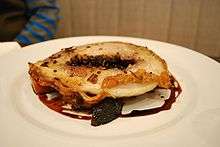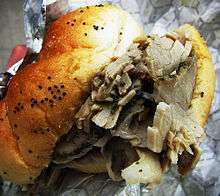Porchetta


Porchetta [porˈketta], sometimes also spelled as porketta, is a savoury, fatty, and moist boneless pork roast of Italian culinary tradition. The body of the pig is gutted, deboned, arranged carefully with layers of stuffing, meat, fat, and skin, then rolled, spitted, and roasted, traditionally over wood. Porchetta is usually heavily salted in addition to being stuffed with garlic, rosemary, fennel, or other herbs, often wild. Porchetta has been selected by the Italian Ministero delle Politiche Agricole, Alimentari e Forestali as a prodotto agroalimentare tradizionale (“traditional agricultural-alimentary product”, one of a list of traditional Italian foods held to have cultural relevance).
In Italy
Although popular in the whole country, porchetta originated in central Italy, with Ariccia (in the Province of Rome) being the town most closely associated with it. Elsewhere, it is considered a celebratory dish. Across Italy, porchetta is usually sold by pitchmen with their typically white-painted vans, especially during public displays or holidays, and it can be served in a panino. It's a common street food in Rome and Lazio served as a filling for pizza bianca. It is also eaten as a meat dish in many households or as part of a picnic.
Porchetta is one of two iconic culinary products of the Lazio region, the other being the sheep cheese pecorino romano. Porchetta is also common in Abruzzo. Porchetta abruzzese is generally slow roasted with rosemary, garlic, and pepper.[1] Porchetta from Umbria is stuffed with the pig's chopped entrails mixed with lard, garlic, salt and plenty of pepper and wild fennel.
Porchetta trevigiana (from Treviso) was developed in 1919. In it, pig is slaughtered when one year old, then its meat is stuffed with salt, pepper, wild fennel, garlic and white wine. It is then roasted inside an oven for seven hours at 200 °C (392 °F).[2] The porchetta is today a popular dish in Venetian cuisine.
The dish is also a staple of Sardinian cuisine. There it is known as "porceddu" and is roasted over juniper and myrtle wood fires.[3][4]
In North America
Porchetta was introduced to the United States by Italian immigrants of the early 20th century, especially immigrants from Abruzzo, and is sometimes referred to as "Italian pulled pork," "roast pork," or "Italian roast pork." It is, in many places, served on a sandwich with greens (rapini or spinach) and provolone cheese.
In Philadelphia and the surrounding area, the dish is usually referred to as simply "roast pork," "roast pork sandwich," "Italian roast pork," "roast pork Italian," "roasted pork," or "porchetta." Philadelphia cuisine is noted for its sandwich form of porchetta, usually served on an Italian roll and often with broccoli rabe instead of spinach and most traditionally with sharp provolone. "Roast pork" is a staple of Philadelphia Italian-American and South Philadelphia cuisine, with restaurants such as DiNic's Roast Pork in the Reading Terminal Market and John's Roast Pork, Esposito's Porchetta, and Tony Luke's in South Philadelphia being well known for their porchetta or "roast pork" sandwiches.
Bridgeport, Connecticut, has a Saturday afternoon lunch tradition of porchetta sandwiches served at community restaurants and taverns that dates back to the first wave of Italian immigration in the early 20th century. The dish is served with pepperoncini.
Porchetta is celebrated in the form of a Sagra every July in Austin, Texas. The porchetta and roast beef sandwich traditions are celebrated in the form of an annual bus tour every first Saturday in March in Bridgeport, Connecticut, organized by The Porchetta Project.
Porchetta is also very popular in Northern Ontario (notably Sudbury and Sault Ste. Marie) and Southern Ontario (in areas such as Hamilton and St. Catharines), and the term "porchetta" is widely used by Italian-Canadians, instead of simply "roast pork". Porchetta (sometimes spelled "porketta") is also popular in the Upper Midwest, having been brought to the Michigan and Minnesota Iron ranges by Italian immigrants.
The porchetta culture in Sudbury, Ontario, Canada, runs perhaps deeper than anywhere outside of its native Italy. Italian settlers passed on their love for porchetta to their children and friends in this region. Old family secrets of spicing, rolling and roasting are passed on, extending commercially into butcher shops as well as in the form of fast-food sandwiches offered in various locally owned shops.[5] "Porketta Bingo", a variation on the traditional Canadian meat draw, is a popular Saturday afternoon activity in Sudbury.[5] Game winners receive one pound of porchetta and a sourdough bun. There are usually between four and seven rounds of six games each, depending on the establishment.[5] Proceeds of Porketta Bingo usually go to a local charity or are donated to local hockey associations.[5]
See also
References
- ↑ Di Gregorio, Luciano (2013). Bradt Abruzzo. Bradt Travel Guides. Retrieved 6 January 2016.
- ↑ Porchetta Trevigiana
- ↑ "Un weekend a...Cagliari". Adnkronos. 2015-02-13. Retrieved 4 March 2015.
- ↑ "Traveller's Guide: Sardinia". The Independent. 10 May 2014. Retrieved 4 March 2015.
- 1 2 3 4 "Sudbury’s signature dish is porketta". Toronto Star, January 9, 2012.